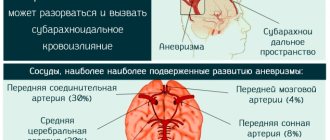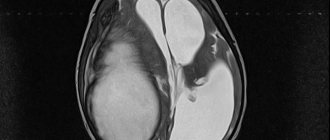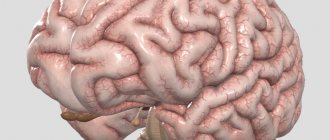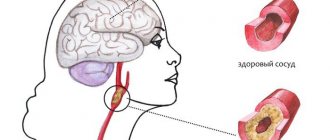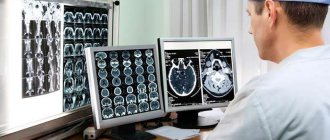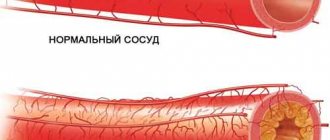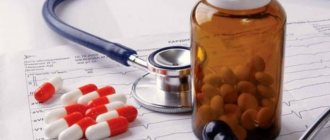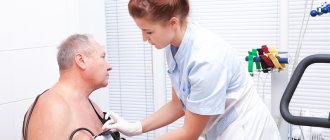Atherosclerosis of cerebral vessels is a disease caused by the formation of atherosclerotic plaques in the vessels of the brain and is threatened by the development of a stroke. The insidiousness of this disease is that at the beginning of the development of the disease, a person does not feel serious symptoms; even when the lumen of the arteries is reduced by half, only noise in the head, tinnitus, and dizziness may occur. Our article is about how the development of cerebral atherosclerosis occurs, as well as about the treatment of cerebral atherosclerosis. Plaque formation occurs in several stages:
Stage 1 - the stage of fatty spots, stripes. During this stage, lipids, mainly cholesterol, are deposited in the inner lining of the walls of blood vessels.
Stage 2 - liposclerosis. In the area of fatty spots, connective tissue forms and a plaque forms. Its surface can ulcerate, crack, and fibrin and platelets settle in the cracks. The plaque is unstable, small parts can come off from it and, with the blood flow, enter smaller vessels in the brain and clog them.
Stage 3 - atherocalcinosis. Calcium salts are deposited and the plaque thickens. Gradually, the plaque increases and can completely block the lumen of the vessel.
How do cholesterol plaques in arteries affect a patient’s health?
Throughout our lives, our brain is supplied with oxygen for proper functioning, which enters the organ through blood vessels. But by the age of 40/45, the arteries become so narrow that doctors diagnose central chronic atherosclerosis. This diagnosis is not entirely correct; cholesterol deposits on the walls appear on virtually all small highways up to the capillaries, and not just on large arteries. At this time, the person begins to feel unwell, as acute or chronic circulatory failure develops. Then doctors note ischemia of the tissues of the main organ. Complete obliteration can occur only after 55 years. Since the course of the disease passes slowly at first and without any special manifestations, manifestation is determined at a fairly late date. As a rule, this concerns men primarily, because they are susceptible to pathology five times more often than the female population.
Since the result of this manifestation is incurable Alzheimer's and Parkinson's diseases, as well as stroke, for physicians this has become a global problem in modern neurology. They encourage patients to undergo an annual free medical examination in order to identify a dangerous pathology as early as possible.
Still have questions?
Send a request and we will be happy to answer them
Stages of development
The disease develops in stages:
- The initial stage of diffuse changes in the vascular walls, the formation of atheromas (cholesterol plaques). Yellow or brown stripes appear on the walls of blood vessels, oriented along their length. Negative factors and bad habits accelerate the formation of deposits. At this stage, characteristic clinical signs may be absent.
- Progressive stage. Hardening of lipid deposits and inflammation of blood vessels occurs in the area where yellow streaks form. The body turns on defense mechanisms. Inflammatory processes lead to the penetration of accumulations into the tissue of the vascular walls. Fatty deposits take on the appearance of capsules rising above the arterial walls.
- Stage of decompensation. An atherosclerotic plaque ruptures with a large release of blood, which rapidly thickens under the influence of fats. This is how blood clots form. A characteristic complication is atherocalcinosis. The formed blood clots with vascular atheromas clog the lumen of the vessel, which leads to strokes, heart attacks and necrosis.
Symptoms and signs of atherosclerosis of blood vessels and arteries of the brain
A person feels great, does not go to a medical facility, and suddenly begins to feel tired and unwell. He eventually comes to the therapist with specific complaints. He does not understand what he can do to stop the dizziness, the noise in the ears, how to restore memory and former concentration, how to increase the speed of thinking and overcome lethargy.
Distinctive characteristics of the disease
The patient's ailments mainly occur during physical activity. At this time, due to the appearance of cholesterol plaques on the walls of the arteries, oxygen deficiency occurs. But do not think that tissue ischemia occurs when the passage is completely blocked. Even if the blood flow was slightly blocked, you will feel not a completely healthy person.
But after a little rest you will feel better for a while. Symptoms recur over and over again and become so severe that you experience:
- Frequent mood changes. Attacks of aggression and irritability are replaced by apathy and indifference to everything around.
- Headaches often begin.
- Memory deteriorates, the level of intelligence decreases. Now you won't be able to say the phrase you had in your mind. In addition, a factor of poor reminiscence is performing a simple exercise. Try to remember and recite the multiplication table. If there are gaps in knowledge, then it’s time for you to consult a doctor!
- Sometimes people around you notice and tell you that your head and hands are shaking.
- If your relative often feels tingling in his fingers, or even worse, partially lost sensitivity, this is a signal of the first signs of advancing senile dementia. We must warn you that the disease cannot be cured, but its progression can be slowed down. In this case, all body functions suffer. In this case, all problems fall on the shoulders of the closest relatives. What should an elderly person do if he does not live surrounded by family? The only correct way out is to place him in a private boarding house for the elderly. Your relative will be under constant medical supervision and supervision. For example, it specializes in such patients.
With the natural aging of the whole organism, we stop paying attention to clinical manifestations, considering them normal during aging.
But it is still worth noting that the development of the disease is accompanied by the following symptoms:
- When you suddenly get out of bed, black spots appear before your eyes.
- Blood pressure jumps and a strong pulsation is visible in the neck.
- During night sleep, the patient wakes up several times, and is haunted by constant nightmares.
- The person does not understand where he is going, and his movements become slow and awkward.
- The optimistic attitude towards life disappears, and a period of constant prolonged depression sets in.
- Sweating increases.
- The face resembles a mask distorted by a grimace.
Of course, these symptoms can be attributed to any disease. Therefore, accurate diagnosis in a medical institution is necessary.
Stages of cerebral artery atherosclerosis
After an examination, doctors can determine with 100 percent accuracy what stage of the disease you are at:
- The first is characterized by overlapping of the vessels by a quarter. In this case, the pathology does not manifest itself in any way. Only an experienced diagnostician is able to identify this stage at an early stage.
- The second is manifested by symptoms in the form of fatigue after performing physical work. The vessels are blocked by a third.
- The third is already the most severe form, in which cognitive (mental) function is impaired. There is an irreversible process of death of brain cells.
Still have questions?
Send a request and we will be happy to answer them
Kinds
There are two types of vascular sclerosis lesions in the brain:
- Stenosing systemic atherosclerosis;
- Non-stenotic vascular sclerosis.
If atherosclerotic deposits develop in the arteries without bulging into the lumen, then the blood flow has a lower speed, and the circle of Willis can redirect it to the necessary vessels of the brain. This is a type of non-stenotic atherosclerosis.
At a severe stage of development of the pathology, the plaque can block the flow of blood and cause blockage of a brain vessel.
The stenosing type of sclerosis is a plaque that grows inside the lumen, and the progression of the pathology occurs quite quickly, which can lead to death in a short period of time.
Stenosing sclerosis is very life-threatening.
Stenosing type of sclerosis
Preventive actions
At a young age, we don’t even think about what a serious illness can lead to. But still, after 25 years, if possible, stop drinking alcohol and smoking. In addition, you must adhere to a healthy diet. You should give up fast food, fatty and high-calorie foods, which lead to the deposition of cholesterol not only on the figure, but also in the brain. Make it a habit to spend five minutes doing morning exercises the same way you brush your teeth. Avoid the elevator and try to go up and down the stairs. After work, walk most of the way in any weather. Visiting the pool has a great effect on the health of the whole body.
A free annual examination is organized for you at the hospital at your place of residence. Don't ignore this and take advantage of a good offer.
Prevention
Below are a few useful habits that will help significantly reduce the risk of developing atherosclerosis:
- to give up smoking;
- nutrition balanced in composition of nutrients;
- correction and maintenance of optimal body weight;
- annual preventive monitoring of lipid and blood sugar levels.
The diagnostic capabilities of our center allow us to establish a diagnosis quickly and accurately. Based on the results of the examination, you will be advised by experienced neurologists, whose knowledge has helped save hundreds of patients.
Also, individual health monitoring programs have been developed on the basis of the Federal Scientific and Clinical Center of the Federal Medical and Biological Agency of Russia.
- for men (under 40 years old, over 40 years old, standard);
- for women (under 40 years old, over 40 years old, standard based on age and optimal)
Don't put off taking care of your health. Call us or make an appointment to assess your risk of atherosclerosis and receive comprehensive recommendations.
Diet food
Initially, many of us start our day incorrectly. We are always in a hurry to get somewhere and instead of having a full breakfast, we drink coffee and run to work. Then at lunchtime we try to snack on unhealthy hamburgers, hot dogs, pizza and shawarma. And in the evening we prefer fried potatoes in lard to salad. If you want to maintain a clear mind and physical activity into old age, then review your diet:
- Cook food steamed, boiled with the addition of olive or sunflower oil.
- Avoid fatty pork. It is better to use all types of fish or turkey, rabbit, and chicken meat.
- Include more fresh vegetables, fruits and herbs.
- If you are not allergic, eat nuts.
- All types of grains are good for breakfast.
- Fermented milk products (kefir, fermented baked milk, milk, cottage cheese and low-fat cheese).
- Dried fruits and compotes made from them are perfect not only for preventing blockage of blood vessels, but also for cleansing the gastrointestinal tract.
Try to divide your food into five to six servings. Drink plenty of clean, still water throughout the day.
Diet
Changing your diet is also a way to improve your well-being and is a great help for other treatment methods. Atherosclerosis very often progresses precisely against the background of poor nutrition and lifestyle, so it is necessary
- follow a certain diet:
- reduce consumption of red and fatty meats and meat in general;
- limit the consumption of confectionery products and baked goods;
- eat as few egg yolks as possible;
- limit solid vegetable fats – margarine – in the diet;
- completely eliminate alcohol, sausages, fast food, and canned food.
Recommended products include vegetables (fresh, pickled, dried), cereals (rice, buckwheat, barley, millet, oats, flax, etc.), dried, fresh and dried fruits, turkey and chicken fillets, river and sea fish.
You need to eat at least 5 times a day at the same time in small portions. It is necessary to avoid fried foods and prepare food using the methods of boiling, steaming, stewing, and baking.
Forecast of the course of the disease
It all depends on the individual characteristics of the person and timely diagnosis. For some, the disease does not show clinical signs and does not cause harm until old age. For others over 60 years of age, ischemic stroke may occur due to narrowing of the lumen in the blood arteries and the formation of clots. Here, without proper treatment, the patient is unlikely to survive or remain disabled. Closer to the age of 70, older people are diagnosed with chronic impairment of mental and physical abilities. Unfortunately, time has been lost, and therapeutic treatment will only support the patient in this condition, but it is no longer possible to completely cure it.
What are the forms of atherosclerosis
Examination reveals either a progressive or central appearance. Each has its own characteristics and manifests itself in different ways.
Progressive
In a very short time, a practically healthy person turns into a “wreck.” His coordination of movements is severely impaired, memory loss occurs, his mood changes, including aggression, and other symptoms appear that we described above. It is necessary to act with lightning speed, undergo examination and begin treatment prescribed by a neurologist.
Cerebral
In this case, the spinal cord is affected. Due to the increase in connective fibers in the main arteries of large arteries, in some areas the vessels become clogged and lose their elasticity. Therefore, in the affected areas there is constant stenosis (narrowing of the lumen). The severity of the disease depends on the interaction of neurons in diseased vessels.
What complications can there be and why is the disease dangerous?
Atrophy of brain capillary tissue can lead to psychological problems, including mental illness. And impaired motor coordination and memory loss often lead to death.
Complications include:
- ischemia of brain tissue;
- epilepsy;
- hemorrhage due to rupture of blood vessels;
- dementia.
It is important to know that even modern medicine and innovative technologies used in treatment cannot completely relieve the patient of symptoms.
Conservative treatment regimens are proposed, which reduce symptoms and eliminate the possibility of death. The exception is a disease detected at an early stage. Therefore, we recommend contacting a neurologist for help as soon as possible!
Causes of the disease
Atherosclerosis occurs against the background of lipid metabolism disorders (dyslipidemia), in which the balance of lipoproteins of different densities changes, and they begin to be deposited in the vessel wall, gradually worsening blood flow. There are many factors that influence this process: from poor diet to congenital enzymopathies. The exact cause-and-effect chain of atherosclerosis still remains unknown.
Risk factors that cannot be controlled
Parameters that cannot be corrected by humans include:
- genetic predisposition;
- age;
- floor.
Modifiable risk factors
Elimination of the following processes and conditions will significantly reduce the risk of developing cerebrosclerosis:
- arterial hypertension;
- smoking;
- insulin resistance;
- diabetes;
- overweight;
- physical inactivity.
Diagnostic methods
When a patient comes to the clinic, he is initially interviewed and complaints are listened to. Additionally, an examination is prescribed using special equipment and laboratory tests.
Still have questions?
Send a request and we will be happy to answer them
Instrumental examination
Since symptoms can be a sign of other diseases, the neurologist sends the patient for consultation with an otolaryngologist (if there is hearing loss) and an ophthalmologist (if there are vision problems). In addition to this, an examination is carried out using specialized devices. EMR, scanning, ultrasound, radioencelogram, and angiography are performed (the newest method where a substance of a different color is injected directly into the vessels).
In addition to instrumental examination, various tests are used:
- Ask the patient to look up.
- They look at coordination and the ability to maintain balance. To do this, the patient stands up straight and stretches his arms in front of him.
- Observe whether tremor of the fingers exists or not.
- Like putting a finger to your nose when your eyes are completely closed.
Laboratory examination
The patient undergoes an extensive blood test to determine how much lipoproteins, cholesterol and triglycerides are present in the composition. The indicators are not a 100% guarantee of the presence of atherosclerosis, but will help to classify the patient into this risk group.
Diagnostic procedures
Cerebral atherosclerosis is diagnosed by a neurologist. Information obtained after testing and patient complaints are taken into account. Diagnosis of cerebral atherosclerosis by laboratory methods:
- Immunological analysis.
- Biochemical, allowing to identify the amount of triglycerides.
Instrumental methods: examination of blood vessels under ultrasound, MRI, Dopplerography, angiorrhaphy.
How to treat cerebral atherosclerosis
Depending on the symptoms and the identified degree of development of the pathology, complex therapy is prescribed to cleanse the bloodstream. Such patients are prescribed lifelong treatment with drugs that reduce blood viscosity, improve oxygen supply to organ tissues, and correct blood pressure.
Courses must be taken in early spring and late fall. In addition to drug therapy, dietary nutrition and procedures in physical rooms are prescribed.
Pathogenetic agents
In order to reduce the absorption of cholesterol from food, anti-metabolic resins are prescribed, such as Hemphribrozil, Cholestyramine. Statins reduce the size of cholesterol plaques. Fibrates help reduce the concentration of triglycerides in the blood, thereby slowing down the rapid progression of the disease.
"Nifedipine", "Vinpocetine", "Pentoxifylline" restore the composition and quality of blood. Various nootropics improve neurometabolism and reduce neurological manifestations.
Drugs to stabilize blood pressure - antihypertensives
To prevent a stroke or other serious complication from occurring, the following medications are prescribed daily: Valsartan, Ibertan, Angiocardil.
Antioxidants
As the disease progresses, dramatic changes in blood plasma occur. Therefore, drugs are prescribed that help reduce the risk of coronary disease: Actovegin, vitamin E, Ascorbic acid.
Combination drugs
For cerebral circulation, drugs are often prescribed that are used in long courses: Cavinton, Piracetam, Cinnarizine, Dihydroergocryptine.
Antidepressants, tranquilizers and psychotropic drugs for symptomatic therapy
This is necessary to eliminate mental manifestations. Individually prescribed drugs affect neurotransmitter systems.
Surgical intervention
The patient is sent for surgery after a thorough examination if the lumen in his vessels and arteries is blocked by lipid deposits by almost seventy percent of the total volume.
To do this, various methods are used using lasers and innovative technologies:
- An atherectomy removes deposits inside the blood vessels along with small areas of tissue.
- During bypass surgery, a new vessel is created and installed. And the one who is struck is removed.
- When stenting, an expander is installed into the line, soaked in a special solution that dissolves cholesterol.
It is worth understanding that surgery is a last resort when drug treatment has not brought positive results. The doctor selects the type of operation for a particular patient individually.
Non-drug therapy
In addition to taking medications, the patient is prescribed a special diet and physical therapy. The exercises shown in the gym are so simple that anyone can do them at home.
How to clean blood vessels using folk remedies
Before using “grandmother’s” recipes, as well as all those indicated in the article, you need to consult your doctor about this.
As practice has shown, the most effective were the following decoctions:
- from plantain leaves. This plant grows in all regions of Russia. It can be dried for future use in a dark and dry place. Grind the ingredients in a blender. Pour one glass of boiling water over just 1 tablespoon of the plant. Cover with a warm blanket and let sit for half an hour. Drink small sips throughout the day;
- from the herb thyme. It is necessary to brew in the following proportions: 1 tablespoon per half liter of water. After infusion, the mixture is filtered and drunk 2 times a day.
Drug treatment
All medications are prescribed by your attending physician and taken under his supervision. Dose adjustments should only be made by a doctor. The following groups of drugs are used:
Statins (Liprimar, Atoris, Zocor, Mertinil and others) - these drugs reduce the level of cholesterol in the blood to normal and help the atherosclerotic plaque to stabilize and not increase in size. The dose is selected by the doctor, which depends on the cholesterol level (normal cholesterol in the blood). The drug should be taken daily, once a day. Efficiency monitoring is carried out after 2-3 months. Based on the results of the blood test, a dose adjustment is possible, which is carried out only by the attending physician. The use of these drugs should be treated with extreme caution, weighing the risks and benefits of their use, since they have serious side effects; according to American experts, it is advisable to take them only for people with serious heart and vascular diseases (see cholesterol tablets are static - harm or benefit).
Fibrates (fenofibrate) - reduce triglyceride levels. Taken in courses, treatment is monitored after 1-2 months of continuous use.
Nicotinic acid , as well as its derivatives, these drugs can sometimes be used in the treatment of cerebral atherosclerosis. These medications reduce triglyceride levels and total cholesterol, and help increase the level of high-density lipoproteins, which have anti-atherogenic properties.
Antiplatelet agents (thrombo ass, cardiomagnyl) are drugs that thin the blood, which reduces the risk of blood clots.
vitamins , vitamin C, vitamin A - have a general strengthening effect and are classified as auxiliary therapy.
Bile acid sequestrants (cholestide) are ion exchange resins that can bind fatty acids in the intestine and prevent them from being absorbed.
Ezetemibe interferes with the active absorption of cholesterol in the intestine. Ezetemibe (Ezetrol 28 pieces 2000 rubles) is a new lipid-lowering drug, unlike Orlistat, it does not cause diarrhea.
Antihypertensive drugs are medications that lower blood pressure.
They should be taken daily (see high blood pressure pills). If these medications are not taken regularly, the risk of hypertensive crisis sharply increases, which, in combination with atherosclerosis, can lead to stroke and disability, as well as death. Read more about how to lower cholesterol without drugs and the benefits of pine cones for stroke in our article.

